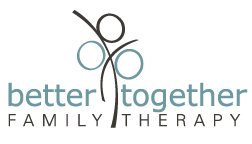Have a Better Holiday with Your Family (Yes, the one you already have)
Our Maryland therapists’ guide to healthier family connections at the holidays
You can have a better holiday with your family by using one simple tool. What is this magical tool? It’s something called “turning toward,” and it’s more important than ever now that families can spend hours together without looking up from tablets or smartphones.
This tool comes from Drs. John and Julie Gottman and their extensive research on the factors that “divorce proof” a marriage. The good news is that it can also be used to improve family relationships.
Do your family relationships cause anxiety?
Anxiety in families is often the result of poor boundaries. Before deciding to get closer to someone, consider this important caveat: Just as your child isn’t obligated to give a hug to anyone, you are not obligated to stay connected with anyone. This tool is intended for use in family relationships that you wish to maintain and strengthen.
If your family relationships are bringing you extreme stress, consider consulting a therapist.
But if they just cause the usual amount of stress, try “turning toward” them, and see what changes. To understand what it means to turn toward your family, we must first understand some of the patterns that underlie all relationships.
A relationship is a perceived connection between two or more people. You likely have many people you feel connected to in different ways. You may have friends or family members that you don’t see often, but feel very close to when you do talk or meet up. You may have others that you see regularly. In each of these relationships the connection is maintained differently, but it has to be maintained or the relationship ends.
A connection between two people has two parts:
Making a “bid for connection” or attempt to connect. Bids for connection include plans for a shared activity or attempts at conversation. For example, your family member may call or text you, or invite you to a dinner party. For children and romantic partners they also often include a physical connection like holding your hand or giving a hug.
Accepting that bid or “turning toward.” Turning toward means engaging in the conversation or participating in the activity. In other words, it’s simply saying “yes” to others’ attempts to connect.
A strong connection requires turning toward bids for connection at least some of the time. In friendships, not returning a single call or text may not be much of a problem. However, if you never return the call or attend the party the friendship is likely to end.
Family relationships have a higher tolerance for missed opportunities to connect. In other words, a bid for connection that goes unanswered probably won’t end your relationship with your family. Turning toward bids for connection more often, however, will improve your relationships overall.
When your family members get it wrong: boundaries, ADHD, and more
If you are spending the holiday with family, you will likely receive many imperfect bids for connection. Rarely do our family members come to us and say “I’ve missed you. Please come spend some time with me.” Instead they may start arguments, say something critical, or otherwise push our buttons. When you understand these interactions as attempts to connect, you are more likely to turn toward them and feel positively about your holiday time with family. Bids for connection may look like this:
Your ADHD child runs into the room and jumps on you.
Your aunt offers help in the kitchen that you don’t really need or want (not understanding your boundaries).
Your partner makes a comment to you about Grandpa’s crazy sweater.
Your mother invites you to do a jigsaw puzzle while you’re busy setting the table.
Your brother tells you his take on the impeachment hearings.
How might you respond to each of these? Would any of them start an argument? How would you respond differently if they read like this?
Your child asks for your attention.
Your aunt tries to share your workload with you.
Your partner looks for a way to laugh together or share a secret with you.
Your mother tries to spend time with you.
Your brother starts a conversation with you.
Setting boundaries with your family and turning toward them
In some families bids for connection may double as boundary violations. You are not obligated to remain in relationship with or turn toward anyone who has violated your boundaries. However, in families we often endure some inappropriate comments from people to whom we would like to remain connected.
One option is to ignore inappropriate bids for connection and accept only the appropriate ones. However, the inappropriate bids are not likely to stop without a more direct conversation. You may need to set a boundary in the process of turning toward someone you’d like to remain close to. Here’s how that might look:
Mom: You’re looking heavier this year. Are you working out?
Setting boundary only: It really hurts my feelings when you monitor my weight. I’ll take care of my body in the way that I choose.
Setting boundary + turning toward: I’d rather not discuss that. Let’s talk about something else. How is your volunteer work going?
Recognizing the bid for connection that comes within the inappropriate comment can help you improve the connection while also setting a boundary.
If you are spending the holiday with your family, congratulations. You have already accepted some bids for connection. Are you attending a family celebration at someone else’s house? You turned toward that family member when you accepted the invitation. Are you hosting? You made a bid for connection by inviting family members. This is true even if it’s a family tradition or expectation.
Now make the most of your time together by accepting bids for connection throughout the day. Interested in learning more about building strong family relationships? Try coming to family therapy alone.
